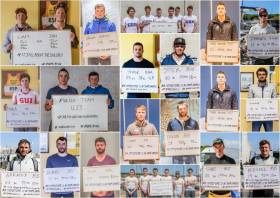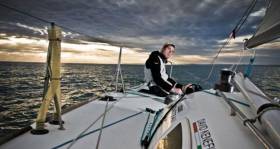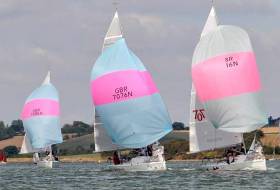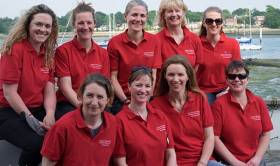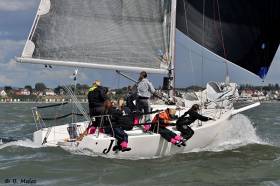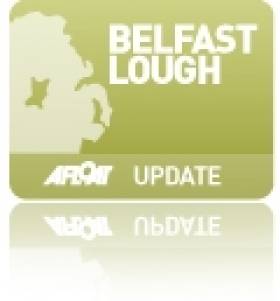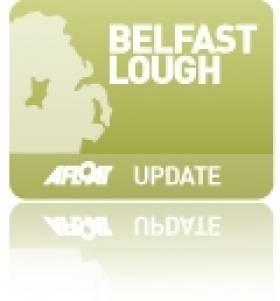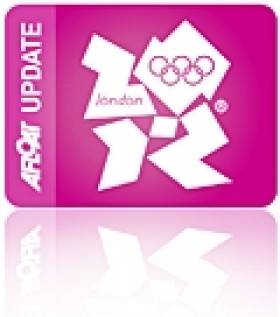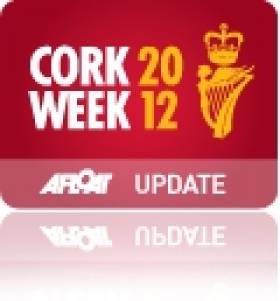Displaying items by tag: Keelboat
Special World Sailing Council Meeting Confirms Olympic Keelboat Event Over Finn Class
Minutes of the meeting that decided the inclusion of an Olympic keelboat event in place of the Finn class have been confirmed by the World Sailing council, according to Sail World.
Controversy has arisen after last month’s decision at World Sailing’s AGM in Florida and the publication of the draft minutes, when four members claimed their electronic votes were recorded incorrectly.
However, in a special teleconference last Friday 21 December, World Sailing’s council voted 22-11 with two abstentions to confirm the previously disputed minutes.
It means that the Mixed Two Person Offshore Keelboat event will go ahead at the Paris Olympics in 2024 — with no more room for Finn sailors.
Ireland has two in the Finn — Oisin McClelland and Fionn Lyden — competing for a place at Tokyo 2020, what’s now the last Olympic Games for the class. The move has been eyed with interest by Irish offshore sailors.
Sail World has further details of last weekend’s special World Sailing council meeting.
Irish Sailors Eye New Olympics Mixed Keelboat Event With Interest
As reported earlier today, World Sailing’s AGM confirmed the inclusion of a new Mixed Two-Person Keelboat event to replace the previously agreed Mixed One-Person Dinghy at the Paris Olympics in 2024.
The International Finn Association has released a statement on the decision, which for now means the removal of the Finn class (indicated at the male equivalent in the Mixed One-Person Dinghy) from future Olympic Games after Tokyo in 2020.
Details have yet to emerge as to what boat will be used by those competing in the new mixed keelboat event, and evaluations may to be concluded by the Equipment Committee by next summer’s Mid-Year Meeting.
However, the development has already sparked interest — if not necessarily a desire to take part — among Irish keelboat sailors at the highest levels.
Thomas Dolan said he has the Paris Olympics squarely in his sights “especially as I should have a few years’ Figaro behind me by then”.
But the mixed keelboat news came as a surprise to the solo sailor, who had thought the idea to be a “dead duck” before last week’s announcements.
Meanwhile, David Kenefick admitted that he has “never had much desire” to go the Olympic route — though “if there was a Moth that might change”.
He added: “It would also be interesting to see what an offshore Olympics class would be like.”
However, Kenefick cautioned that as much as it’s an idea he would like to see, “I think it would be very expensive and with a low attendance" for 2024 at least.
The Royal Corinthian Yacht Club, Burnham-on-Crouch (RCYC), and the Royal Yachting Association (RYA) have announced the launch of the Keelboat Endeavour Trophy writes Sue Pelling.
The aim of this new event, scheduled to take place on 22-23 September 2018, is to establish the UK keelboat champions of champions’, in a similar format to the long-running and successful annual Endeavour Trophy for dinghies.
Using up to six of the RCYC’s fleet of 707s, the Keelboat Endeavour Trophy will be run in a British Keelboat League-style knock-out format with 25 plus races over the weekend, and with RYA on-the-water umpires keeping an eye on proceedings.
The team behind the RCYC and RYA joint venture, including Edwin Buckley (RCYC Event Director), Bas Edmonds (RYA Racing Services Manager) and Jack Fenwick (RYA Keelboat Development Manager) say after three years in the planning they are thrilled to finally be able to launch the event.
Edmonds commented: “It has been a long time coming but we are now in a position to run an event that we [RYA and Royal Corinthian YC, Burnham-on-Crouch] believe will become as significant as the dinghy Champion of Champions’ Endeavour Trophy.
“As far as entries go, we are trying to be as inclusive as possible, particularly in the first year so classes like the J/109, J/111, Fast40s, and potentially the IRC national champion have the opportunity to come along. We also expect to see a large contingent of champions from classes like the Squibs, Flying 15s and local one-designs that run a national championship and have exceptionally high quality competition.
“The launch of this event couldn’t have come at a better time because we are really noticing a bit of ascendancy in keelboat racing at the moment. Certainly the smaller dayboats are seeing a resurgence.
“Overall, I think it is a really good time for keelboat sailing and I can confirm the Royal Corinthian at Burnham, and the RYA are pretty excited about having an opportunity to showcase keelboat sailing at its best.”
Buckley, who is delighted to be able to build on the success of the Endeavour, added: “This is also another step in history of the Endeavour and I know that the original founders of the dinghy event that celebrates 58 years this year, would be delighted to see the Endeavour Trophy evolve by expanding the event from dinghies to keelboats.”
A total of 24 keelboat teams are expected to contest the title, which will take place over short, windward/leeward courses on the tactical, tidal waters of the River Crouch and Roach.
The organisers of the event are keen to encourage keelboat classes to lodge an interest in putting forward class representatives from the 2018 national championships that take place throughout the summer.
Irish Ladies Sailing Team Led By Laura Dillon Win Dubarry UK Women's Open Keelboat Championships
Last weekend (4/5 June), a team of Irish ladies won the Dubarry UK Women's Open Keelboat Championships 2016. The team included the following Irish lady sailors - Laura Dillon (helm), Karena Knaggs, Katie Dwyer, Ali Clarke, Trisha Daly, Jennifer Toettcher and Audrey Adamson. We were sailing on Louise Makin and Chris Jones’s J/111, Journeymaker II. In addition to the Irish ladies, the team included the owner and navigator, Louise Makin, Julia Salt, Susie Moore and Andrea Miz.
There were 17 boats in total and the event was held from Hamble River Sailing Club, in very light winds.
Class 1:
1st – 4 pts – Journeymaker 11, Laura Dillon
2nd – 11 pts – SynerJy, Marie-Claude Heys
3rd - 14 pts – Southern Child, Lucy Jones
Class 2:
1st – 7 pts – Blackjack 11, Annie Kelly
2nd – 10 pts – J'ronimo, Libby Greenhalgh
3rd – 11pts – Swallow, Lulu Wallace
The overall champion was again Laura Dillon sailing Journeymaker 11
Dubarry of Ireland will be returning for the fifth year as title sponsor of the Women’s Open Keelboat Championships.
The Dubarry Women’s Open Keelboat Championships is an all-female keelboat regatta taking place in the Solent on 4-5 June 2016 and the organisers believe it is the only event of its kind in the UK.
Dubarry take inspiration from the rugged Wild Atlantic Coast and Galway’s great sailing heritage to create the highest quality leather footwear, deck shoes and sailing boots as well as a range of clothing, leather goods and accessories. Participants in the Dubarry Women’s Open Keelboat Championships will have the opportunity to win much admired Dubarry items, which will be available as prizes for class winners and in the overall Championship.
“The Dubarry Women’s Open Keelboat Championships is an event that we thoroughly enjoy being involved with, both on and off the water. The superb location and excellent organisation is complemented by eager participants with a great sense of camaraderie, making this such a great event for us to be associated with” said Marketing Director, Michael Walsh.
WOKC aims to provide high quality racing amongst female sailors whilst also offering an environment that is encouraging to female sailors newly entering the competitive side of the sport.
Jen Smyth from the WOKC organising team adds, “We are extremely grateful to Dubarry for their continued support, which enables this regatta to continue. The event is great fun, and although we compete passionately on the water the atmosphere is friendly and welcoming. We actively encourage newcomers to join us, so if you are a female skipper or boat owner, please get in touch to find out more.”
Hosted at Hamble River Sailing Club (HRSC), the regatta format focuses on IRC racing with a recommended rating of 0.88 to 1.101, split into suitable classes. One Design Classes will also be catered for if there are sufficient entries. For those with an available boat, but no current IRC certificate, the RORC Rating Office will issue a Limited Validity certificate for single event rating.
The popular Frocks & Flip-flops party takes place after racing on the evening of Saturday 4 June. Lady racers, their supporters and friends can let down their hair and raise some valuable funds for charities.
Entries are now open and early entry is advised to take advantage of the earlybird booking fee of £70, available until 17:00 on Friday 27 May. After that date, entry fee will increase to £90.
Mumbo Jumbo Hangs on for Win at Belfast Lough Autumn Keelboat Series
Charlie West–Hurst's Mumbo Jumbo won their first race of the Belfast Lough Autumn Keelboat Series last Sunday morning, finishing just behind the other NIRKRA competitors to win on handicap. This was the fourth different winner in as many weeks with only 2 minutes seperating the fleet on corrected time.
Racing was postponed initially on Sunday morning with racing looking unlikely with little wind forecast until the afternoon but some lovely early Autumn sunshine for everyone to enjoy. Thankfully after just 20 minutes, a brisk Southerly 8-12 knots set in to Race Officer Colin Loughead's joy who got racing started quickly.
The IRC fleet got away first with Giggle tramping away as expected from the smaller Final Call. The Sigma fleet followed with tight racing around the first two laps when Impulse and Cariad got into a private duel allowing the other two to escape. Sqwawk repeatedly tried to escape Burton Allen's Starshine Challenger upwind but was dragged back on the runs with only boat lengths separating them at the final leeward mark. Paul Prentice's team hung on for a 3rd win in the series and overall lead.
In the Restricted Whitesail NHC class John Moorehead's Margarita scored their second win of the series with a good lead at the finish over Mingulay and the following Enigma.
The smaller NIRKRA fleet saw the tightest racing with David Milne's Manzanita leading from QtPi and Starflash. The latter broke through by the end to finish second over the water but has suffered from her successes earlier in the season and her henceforth higher NHC handicap to drop to 6th on corrected time. Manzanita could look back to see the chasing "slower" Chatterbox followed closely by Mumbo-Jumbo who was enjoying the freshening breeze and won the race by just 10 seconds. The NIRKRA class was set up 2 years ago with a restricted banding centered around the old quarter-tonner mark and this series has shown the competitive nature of the fleet with four different winners in as many races and only 2 points seperating the first 4 boats overall.
Next Sunday's racing looks to be a bit fresher with the imminent leftovers of Hurricane Joaquin. There are 3 races still left in the series with all classes still up for winning. Many thanks to David and Elaine Taylor for lending Whiskey Mac to be the committee boat.
Full results here
New Signings Boost NI Restricted Keelboat Racing Association (NIRKRA)
Since its formation in the early days of 2014 the Northern Ireland Restricted Keelboat Racing Association (NIRKRA) has made significant strides around and beyond the waters of Belfast Lough writes Tom Jobling. The class claims It is the fastest growing keelboat class in the country. Proof of this was evident at their recent 2015 planning meeting at Ballyholme Yacht Club; a transfer to a larger room was necessitated to accommodate the turnout of members.
Tom Bell, secretary of NIRKRA said; "This is an owner-controlled class aimed at 'small keelboats' and designed to give competitive close quarter racing, but at reasonable costs." Robin Gray, the international race officer, added; "The emphasis is on keeping the class within a tight rating band so that racing can indeed be as close as can be. To this end, we use the RYA's NHC handicap system – it has worked a treat for us."
NIRKRA has already attracted a variety of craft into the class – designs include: Manzanita, Starflash, Gibb Sea 80+, Bolero, Contessa 26, Ruffian 23 and Eyghtene 24... Already a number of new signings have joined the fleet in advance of the incoming season. These range from Sonatas to a Polish designed quarter tonner, the Conrad 760. This is very much a 'small acorns' nautical tale... and this season NIRKRA comes of age.
The main NIRKRA activity this season will centre around its monthly Super Sunday 'challenge' series; comprising three back-to-back, windward/leeward races with an early start, the first gun explodes at 10:00 hours! The early start allows the fleet to be ashore for a 'late lunch' — the après sail aspect is a major consideration for the membership; they're commonly referred to as 'nirks'...
As well as their Super Sunday outings, 'nirks' will be supporting the local Belfast Lough Yachting Conference regatta programme, as well as, the Royal North of Ireland YC's Brewin Dolphin Keelboat weekend. They will also have strong representation at the Volvo Dun Laoghaire week.
NIRKRA SUPER SUNDAY Challenge dates:
June 7th Royal Ulster YC
June 28th Carrickfergus SC
Aug 2nd Ballyholme YC
Sept 6th East Antrim BC
#nikra – Despite the horrendous weather which had encircled Northern Ireland last weekend a tiny window opened to allow the August "Challenge" races of the Northern Ireland Restricted Keelboat Racing Association (NIRKRA) to proceed on Belfast Lough. A Bangor bay morning of sun-drenched competition, which after a series of light weather windward-lee races, in turn, saw the crowning of a new 'King Nirk'.
NIRKRA is an owner controlled class designed to give good, competitive, close racing at a reasonable cost. It is aimed at small racing keelboats within the Province with the emphasis on keeping the class in a small rating band so racing is as close as can be. NIRKRA racing is currently run under the RYA's NHC system.
With the NHC numbers revised after the previous 'Super Sunday,' none of the fleet were sure who would profit after the mathematics had had their day. Proceedings were opened by the crew of QT-pi who were taking no chances; at the helm, Ballyhome's Charlie Taylor drove the Gibsea80+ into a commanding lead gained from the second windward leg, and held it to the finish. The Starflash of Alan Morrison & John Simms were second on the water, with the defending 'NIRK' Prodigal, third.
In race two the same three boats were swapping places on the water with Prodigal gaining the final advantage from Starflash and QT-pi. However on corrected time it was the 'Starflashers' who profited yet again. The latest addition to the fleet, Nick & Davy Quinn's Eygthene 24, Chatterbox took third place, and then topped off his Super Sunday with second place in the final race!
For the final race, the wind Gods played their closing card. A lifeless starting line saw most of the fleet in irons. But as the wind again swept in from the west, the last boat away became the first to round the weather mark! Prodigal lead the fleet home, but a surging Starflash was close enough to make it three wins in row on corrected time; it was indeed a 'Super Sunday' for the home club - Ballyholme Yacht Club.
Ashore at BYC, and organised by NIRKRA secretary Tom Bell, the fleet enjoyed a Gourmet Barbeque as well as a 'live session' from the next county Down music superstar Sam Wickens.
RESULTS
POS BOAT TYPE OWNER CLUB SCORE
1 Starflash Starflash A. Morrison/J. Simms Ballyholme YC 3
2 Prodigal Bolero TN Jobling East Antrim BC 9
3 Chatterbox Eygthene24 D&N. Quinn Ballyholme YC 10
4 QT-pi Seagib 80 J. Coffey/T. Bell Royal Ulster YC 11
5 Mumbo Jumbo Contessa 25 C. West-Hirst/K. Storey Royal Ulster YC 12
Irish Sailors Fight for Medal Race Rights in Miami
#MOCR – A place in this weekend's medal race is the likley prize for Olympic Star keelboat pair Peter O'Leary and David Burrows who have scored top ten results for the third day in a row at the Miami Olympic Classes Regatta. The Cork–Dublin duo, now in seventh overall after a seventh and a sixth scored yesterday, need to continue the consistent performance into today's final round of fleet racing to secure a top ten placing overall.
Dun Laoghaire's single-hander Annalise Murphy in the Laser Radial now in ninth overall is also set for a place in Saturday's medal race having discarded her worst result of 27th, scored yesterday afternoon on Biscayne Bay.
The Irish Paralympic team in the Sonar class had their best day so far of the championship with two fifth places. A protest yesterday evening resulted in their disqualifcation from yesterday's final race but that didn't prevent them from moving up one place on the leader board to seventh overall.
Laser sailor James Espey from Belfast Lough slipped to 22nd overall following two 35th places.
Additional reporting by organisers:
Miami, Florida, USA: A final showdown awaits three Paralympic classes tomorrow and ten Olympic classes on Saturday at US Sailing's Rolex Miami OCR, which has, thus far, gifted sailors with four days of sublime sunshine and satisfying winds. The event is the only one of seven ISAF Sailing World Cup events to grace a shore on this continent and has attracted 529 sailors from 41 countries from as close as Canada and as far away as New Zealand and China.
"It's looking pretty exciting," said Brazil's Star sailor Robert Scheidt, who with crew Bruno Prada has perhaps one of the most impressive sailing records here. (Together, they are two-time Olympic medalists and just off their second straight title win at the Star World Championships). "Some of the guys who have already got a spot in the Olympics are here and they are really sailing well."
No one has been proving that theory better than Sweden's Fredrik Loof/Max Salminen who yesterday trailed Scheidt/Prada by two points and today tied on points with the Brazilians after finishing 6-2 to their 3-7. With both teams posting 26 points, Norway's Eivind Melleby/ Petter Moerland Pedersen are nipping at their heels with only 29 points.
As will happen at the Olympics, only the top-ten boats after tomorrow's racing will be allowed to progress to Saturday's single medal race, which will determine gold, silver and bronze medals.
For the Paralympic sailors here, tomorrow will be the final day of racing (two races each scheduled for Skud-18, Sonar and 2.4mR classes) and determine who takes home medals. (This is the same format that will be followed at their Games.)
Top three podium positions:
Sonar, 10 boats, - 8 races
1. Jourden Bruno / Vimont Vicary Nicolas / Flageul Eric, FRA, 19 points
2. Udo Hessels / Marcel van de Veen / Mischa Rossen, NED, 20
2. John Robertson / Hannah Stodel / Steve Thomas, GBR, 22
Star, 29 boats, - 8 races
1. Robert Scheidt / Bruno Prada, BRA, 26
2. Fredrik Loof / Max Salminen, SWE, 26
3. Eivind Melleby / Petter Moerland Pedersen, NOR, 29
49er, 23 boats, - 12 races
1. Nico Luca Marc Delle Karth / Nikolaus Resch, AUT, 29
2. Erik Storck / Trevor Moore, USA, 33
3. Allan Norregaard / Peter Lang, DEN, 61
Skud-18, 6 boats, - 8 races
1. Daniel Fitzgibbon / Liesl Tesch, AUS, 13
2. Alexandra Rickham / Niki Birrell, GBR, 13
3. Jennifer French / Jean-Paul Creignou, USA, 20
2.4mR, 25 boats, - 8 races
1. Damien Seguin, FRA, 13
2. Paul Tingley, CAN, 33
3. Megan Pascoe, GBR, 39
Laser Radial, 60 boats, - 8 races
1. Lijia Xu, CHN, 19
2. Marit Bouwmeester, NED, 25
3. Evi Van Acker, BEL, 38
470 Men, 22 boats, - 8 races
1. Mathew Belcher / Malcolm Page, AUS, 20
2. Sven Coster / Kalle Coster, NED, 24
3. Lucas Calabrese / Juan Maria de la Fuente, ARG, 32
470 Women, 15 boats, - 8 races
1. Lisa Westerhof / Lobke Berkhout, NED, 22
2. Hannah Mills / Saskia Clark, GBR, 23
3. Maria Fernanda Sesto / Consuelo Monsegur, ARG, 31
Laser, Gold,, 37 boats,- 8 races
1. Paul Goodison, GBR, 15
2. David Wright, CAN, 17
3. Bruno Fontes, BRA, 18
Laser, Silver,, 37 boats,- 8 races
1. Marcin Rudawski, POL, 100
2. Ricardo Montemayor, MEX, 103
3. Matthew Ryder, CAN, 114
Finn, 25 boats, - 8 races
1. Zach Railey, USA, 9
2. Jonas Hogh Christensen, DEN, 19
3. Brendan Casey, AUS, 25
RS: X Men, 14 boats, - 8 races
1. Nick Dempsey, GBR, 7
2. Elliot Carney, GBR, 19
3. Mariano Reutemann, ARG, 20
RS: X Women, 12 boats, - 6 races
1. Demita Vega De Lille, MEX, 10
2. Carolina Mendelblatt, POR, 21
3. Farrah Hall, Annapolis, Md., USA, 22
Women's Match Racing
TOP FOUR ADVANCING TO SEMIFINALS
Sally Barkow / Alana O'Reilly / Elizabeth Kratzig-Burnham, USA, 3 wins- 0 losses
Silja Lehtinen / Silja Kanerva / Mikaela Wulff, FIN, 3 wins- 0 losses
Olivia Price / Nina Curtis / Lucinda Whitty, AUS, 3 wins- 0 losses
Lucy Macgregor / Annie Lush / Kate Macgregor, GBR, 3 wins- 2 losses
Lyons Hopes For a Special Cork Week in 2012
#CORK WEEK - Pat Lyons of Royal Cork Yacht Club has spoken to website The Cork News about the city's hopes for the 2012 Cork Week regatta.
Crosshaven in Cork Harbour will host the club's biggest regatta - which takes place every two years - from 7-13 July this summer.
“Sailing in Ireland and Cork is in great shape,” says Lyons, who is expecting more than 250 boats to pack the harbour for racing and more.
The event is also perfectly timed just two weeks ahead of the 2012 Olympic Games in London, where Royal Cork Yacht Clubman Peter O’Leary will vie for gold with Dublin yachtsman David Burrows in their two-man keelboat.
Though the economic downturn has had a serious effect, costs have been cut across the board and some rules have been relaxed to allow for the widest possible level of participation.
“There are three factors that make Cork special," says Lyons. "Firstly, there is the number of boats and the various fleets. Secondly, there are 10 races planned. While that doesn’t always pan out due to the weather, we have pretty settled weather conditions and an excellent coastline in Cork, with hills running down to the sea.
"And finally, there is the harbour, which, if the weather impacts, provides excellent shelter. We’ve always been able to achieve a higher level of competition than a lot of other regattas, with at least one or two races per day.”
As previously reported on Afloat.ie, preparations for the event have already kicked off with the launch of a dedicated new website.
The Cork News has more on the story HERE.


























